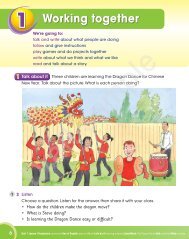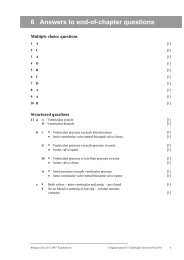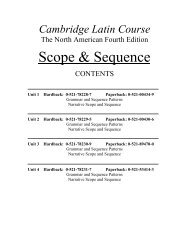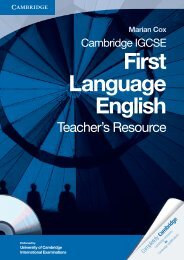Brad Philpot - Cambridge University Press
Brad Philpot - Cambridge University Press
Brad Philpot - Cambridge University Press
You also want an ePaper? Increase the reach of your titles
YUMPU automatically turns print PDFs into web optimized ePapers that Google loves.
Part 3 – Literature: texts and contexts<br />
140<br />
discussion<br />
1 How well do you think the student<br />
has understood the novel? Where<br />
do you see evidence of good<br />
understanding? Is there evidence<br />
of poor understanding?<br />
2 How does the student make a<br />
connection between the context<br />
in which the novel was written<br />
and the themes and structure of<br />
the novel?<br />
Anti-novel is a novel that ignores<br />
all of the structural conventions<br />
of regular novels such as plot,<br />
characterisation and consistent<br />
point of view.<br />
Key<br />
terms<br />
Bildungsroman belongs to a<br />
tradition of novel writing about<br />
young individuals coming of age<br />
who learn a lifelong lesson through<br />
a transformational experience;<br />
the German word Bildung means<br />
‘development’ or ‘formation’, and<br />
roman means ‘novel’.<br />
Gothic fi ction is a mixture of horror<br />
and romance that came out of the<br />
Romantic movement of the 18th<br />
and 19th centuries.<br />
Magic realism is a style of fi ction<br />
with origins in South America. It<br />
creates a very realistic setting with a<br />
few highly unrealistic elements.<br />
Social novel is a type of novel that<br />
stresses the importance of real<br />
social and economic circumstances<br />
on fi ctional characters in an attempt<br />
to persuade the reader towards an<br />
ideological position.<br />
Fahrenheit 451: style and context<br />
To prepare for your Paper 2 exam, you need practice at writing about how the context<br />
of a work is reflected through its content, style and structure. Look at the following<br />
response written by a student after reading Fahrenheit 451.<br />
Ray <strong>Brad</strong>bury was devoted to writing fiction when he wrote Fahrenheit 451. This<br />
may explain why the main topic of the novel is the importance of literature and<br />
books in society. After the Second World War, the memory of Nazis burning Jewish<br />
books was etched into the minds of millions, including <strong>Brad</strong>bury. Besides being<br />
concerned about the rights of minorities in America, his greater issue was with the<br />
state of education and literacy. Visual mass media was on the rise in America in<br />
the 1950s. <strong>Brad</strong>bury feared that with more screens projecting sensational images,<br />
people would forget to read and not want to be bothered with intellectual ideas,<br />
engaging in self-censorship.<br />
The above-mentioned ideas can be seen in the passage from Fahrenheit 451.<br />
<strong>Brad</strong>bury creates a scene with a lot of dialogue between Captain Beatty, who<br />
voices the opinion of the state and the masses, and Guy Montag, who, like the<br />
reader, questions the reasoning behind the state’s ways. As we, the readers,<br />
eavesdrop, we hear the arguments for censorship.<br />
The novel is intriguing. It drops the reader in a strange setting and quickly<br />
explains how to navigate. Because the novel was originally written in instalments<br />
as a serial in both Galaxy and Playboy magazines, it had to be intriguing. It had to<br />
make the reader want to buy the next publication.<br />
So far in this unit you have come across several types of fiction: science fiction,<br />
speculative fiction and dystopian literature, and have looked at these terms in relation<br />
to two novels: The Handmaid’s Tale and Fahrenheit 451. Figure 6.1 shows how a Venn<br />
diagram can be used to show how the two novels, plus some others, can be identified<br />
with the genres and the relationship between then. The diagram allows for an overlap<br />
where some texts have characteristics of more than one genre.<br />
There are, of course, many more genres than the three you have looked at so far in<br />
this unit. The following is a list of some of the other types of novel.<br />
anti-novel<br />
Gothic novel<br />
romance<br />
Bildungsroman<br />
historical novel<br />
social novel<br />
crime / detective novel horror novel<br />
speculative novel<br />
documentary novel magic realism novel spy novel<br />
fantasy novel<br />
psychological novel thriller<br />
Sample<br />
Activity 6.1<br />
1 Construct a Venn diagram like Figure 6.1 (page 139 to show the genres the<br />
books you are reading as a class belong to. Although constructing a Venn<br />
diagram of your texts cannot be an exact science, this is a useful exercise to<br />
do as a class when you are discussing your Part 3 or 4 texts, or even works<br />
you have read outside class.<br />
2 Why do you think the authors chose these particular types of novel to<br />
express their ideas?<br />
© <strong>Cambridge</strong> <strong>University</strong> <strong>Press</strong> 2011








